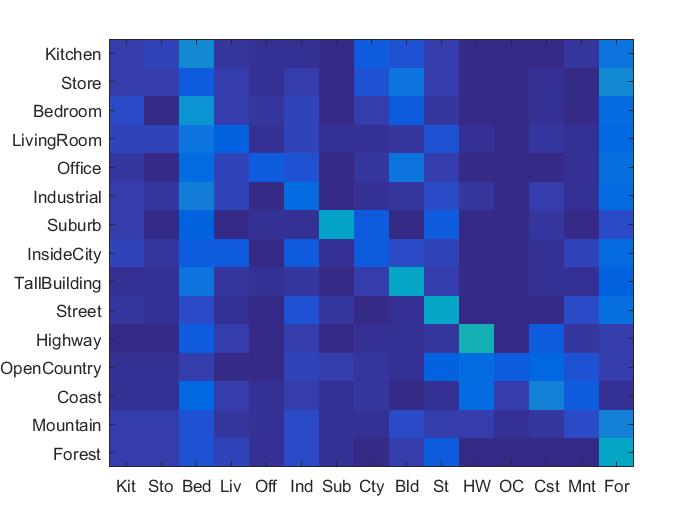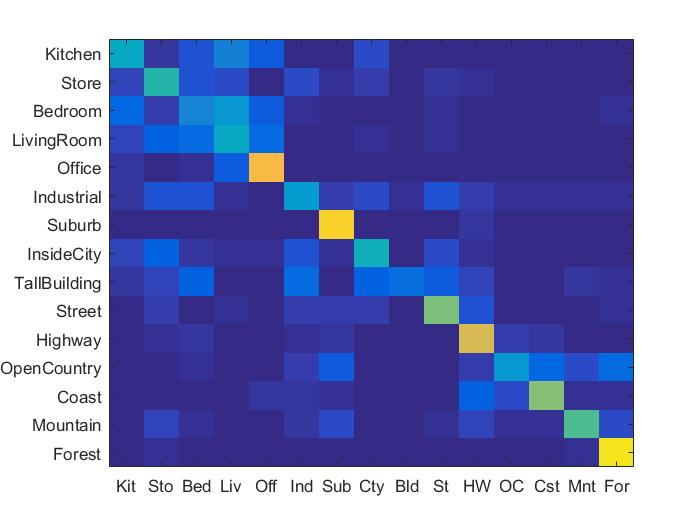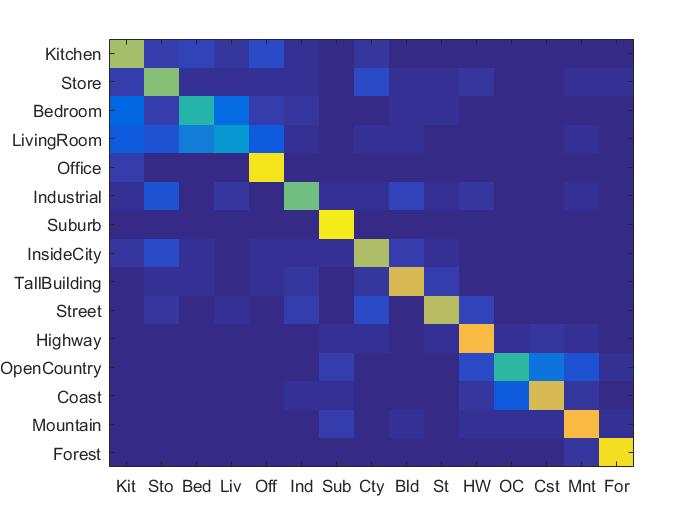Project 4 / Scene Recognition with Bag of Words
Image recognition is one of the most fundamental problem in computer vision. The goal of this project is to classify a scene using different machine learning methods with various complexity. Feature Computation i.e. representation of an image as a vector is used to train and test a classifier. Classififers such as nearest neighbour and SVM were trained using tiny images(simple feature method) and bags of quantized local features (advanced feature method) . The following three combinations of image features and classifiers are implemented and analysed
- Tiny image representation and nearest neighbour classifier
- Bag of SIFT representation and nearest neighbor classifier
- Bag of SIFT reprentation and linear SVM classifier
Image Representation and Feature extraction
Tiny Image Representation
In case of tiny image representation, each image is simply resized to a small fixed resolution of 16x16. The images are made to have zero mean and unit length. Since the image is only resized it is not inavriant to spatial and brightness shifts. Below is psuedo code. It was observed that the results are better when zero mean and unit length operations were applied before resizing the image.
image_height = 16;
image_width = 16;
image_size = image_width * image_height;
[N,~] = size(image_paths);
image_feats = zeros(N,image_size);
for i = 1:N
image_read = double(imread(image_paths{i})); % read the image
image_read = image_read - mean(image_read(:)); % make the image zero mean
image_read = image_read/std(image_read(:)); % normalize the image
image_read = imresize(image_read,[image_width, image_height]); % resize the image
image_feats(i,:) = imresize(image_read',[1,image_size]); % add it to the image_feats
end
Bag of SIFT Features
A vocabulary of visual words which is required to represent training and testing examples is obtained by sampling SIFT descriptors from the training images, clustering them with kmeans, and then returning the cluster centers, which forms the visual vocabulary. The SIFT features for the testing examples are initially computed and then each local feature is assigned to its nearest cluster center by comparing it with the vocabulary that already exists. A histogram indicating how many times each cluster was used forms the feature representation for each image. The histogram is normalized so that a larger image with more SIFT features will not look very different from a smaller version of the same image. Below is the pseudo code of the implementation
for i =1:N
I = imread(image_paths{i});
[~, SIFT_features] = vl_dsift(single(I),'step',3);
D = vl_alldist2(vocab',single(SIFT_features));
[~,Index] = min(D);
histogram = zeros(1,vocab_size);
for k = 1:size(SIFT_features,2)
histogram(Index(k)) = histogram(Index(k))+1; % update the histogram of the corresponding bin
end
image_feats(i,:) = histogram / sum(histogram);
end
Classification Techniques
Nearest Neighbour Classifier
The nearest neighbour classifier predicts the category of every test image by finding the training image with most similar features. Votes based on 4 nearest neighbours are used as the performance was maximum for the given k parameter.
D = vl_alldist2(test_image_feats.',train_image_feats.');
k = 4;
[~,I] = sort(D);
I = I(1:k,:);
labels = train_labels(I);
predicted_categories = [];
for i = 1:size(I,2)
unique_labels = unique( labels(:,i) );
n_class = length(unique_labels);
n = zeros( n_class, 1);
for j = 1:n_class
n(j) = length(find(strcmp(unique_labels{j}, labels(:,i))));
end
[~, index] = max(n);
predicted_categories = [predicted_categories ; unique_labels(index)];
end
Linear SVM
A hyperplane is obtained by learning the feature space. The feature space is partitioned and test cases are categorized based on which side of the hyperplane they fall on. This function will train a linear SVM for every category and then use the learned linear classifiers to predict the category of every test image. Every test feature will be evaluated with all 15 SVMs as there are 15 categories and the most confident SVM will "win". Linear SVMs performs better compared to nearest neighbour as the classifier is not heavily influenced by frequent visual words especially if they represent smooth pateches or gradients or step edges thereby improving the accuracy
categories = unique(train_labels);
num_categories = length(categories);
num_train_images = size(train_image_feats, 1);
LAMBDA = 0.000001;
for i = 1:num_categories
labels = ones(num_train_images,1).*-1;
labels(strcmp(categories{i},train_labels)) = 1;
[W,B] = vl_svmtrain(train_image_feats', labels, LAMBDA);
confidence(:,i) = test_image_feats*W+B;
end
[~, indices] = max(confidence, [], 2);
predicted_categories = categories(indices);
end
Accuracy and Results
1. Tiny Image Representation and k Nearest Neighbour Classifier
1. Tiny Image Representation and k Nearest Neighbour Classifier
k= 4
Accuracy = 22.2%

2. Bag of SIFT Features and Nearest Neighbour Classifier
Vocab Size = 400
Accuracy = 53.3%

3. Bag of SIFT Features and Linear SVM
Vocab size = 400
Accuracy = 69.7%

Extra Credit
Effect of Vocabulary Size
As can be seen below there is a significant improvement in the performance with the vocabulary size going from 10 to 200 but improves rather slowly for larger vocabulary size. As more clusters are used, the impact of noise and the number of dimension in the feature vector increases.

Scene classification results visualization

Accuracy (mean of diagonal of confusion matrix) is 0.697
| Category name | Accuracy | Sample training images | Sample true positives | False positives with true label | False negatives with wrong predicted label | ||||
|---|---|---|---|---|---|---|---|---|---|
| Kitchen | 0.670 |  |
 |
 |
 |
 Bedroom |
 LivingRoom |
 InsideCity |
 Bedroom |
| Store | 0.600 |  |
 |
 |
 |
 Street |
 InsideCity |
 TallBuilding |
 InsideCity |
| Bedroom | 0.430 |  |
 |
 |
 |
 OpenCountry |
 Store |
 Office |
 LivingRoom |
| LivingRoom | 0.340 |  |
 |
 |
 |
 Kitchen |
 Mountain |
 Bedroom |
 Bedroom |
| Office | 0.940 |  |
 |
 |
 |
 Kitchen |
 Bedroom |
 LivingRoom |
 Kitchen |
| Industrial | 0.580 |  |
 |
 |
 |
 Street |
 Store |
 TallBuilding |
 Store |
| Suburb | 0.960 |  |
 |
 |
 |
 Industrial |
 OpenCountry |
 Store |
 Highway |
| InsideCity | 0.670 |  |
 |
 |
 |
 TallBuilding |
 Store |
 Store |
 Highway |
| TallBuilding | 0.740 |  |
 |
 |
 |
 InsideCity |
 InsideCity |
 Store |
 Office |
| Street | 0.690 |  |
 |
 |
 |
 Bedroom |
 TallBuilding |
 Industrial |
 Store |
| Highway | 0.800 |  |
 |
 |
 |
 Street |
 Industrial |
 Forest |
 Coast |
| OpenCountry | 0.470 |  |
 |
 |
 |
 Coast |
 Highway |
 TallBuilding |
 Mountain |
| Coast | 0.790 |  |
 |
 |
 |
 OpenCountry |
 OpenCountry |
 Highway |
 Mountain |
| Mountain | 0.830 |  |
 |
 |
 |
 Industrial |
 Highway |
 Forest |
 OpenCountry |
| Forest | 0.940 |  |
 |
 |
 |
 OpenCountry |
 Store |
 Mountain |
 Suburb |
| Category name | Accuracy | Sample training images | Sample true positives | False positives with true label | False negatives with wrong predicted label | ||||